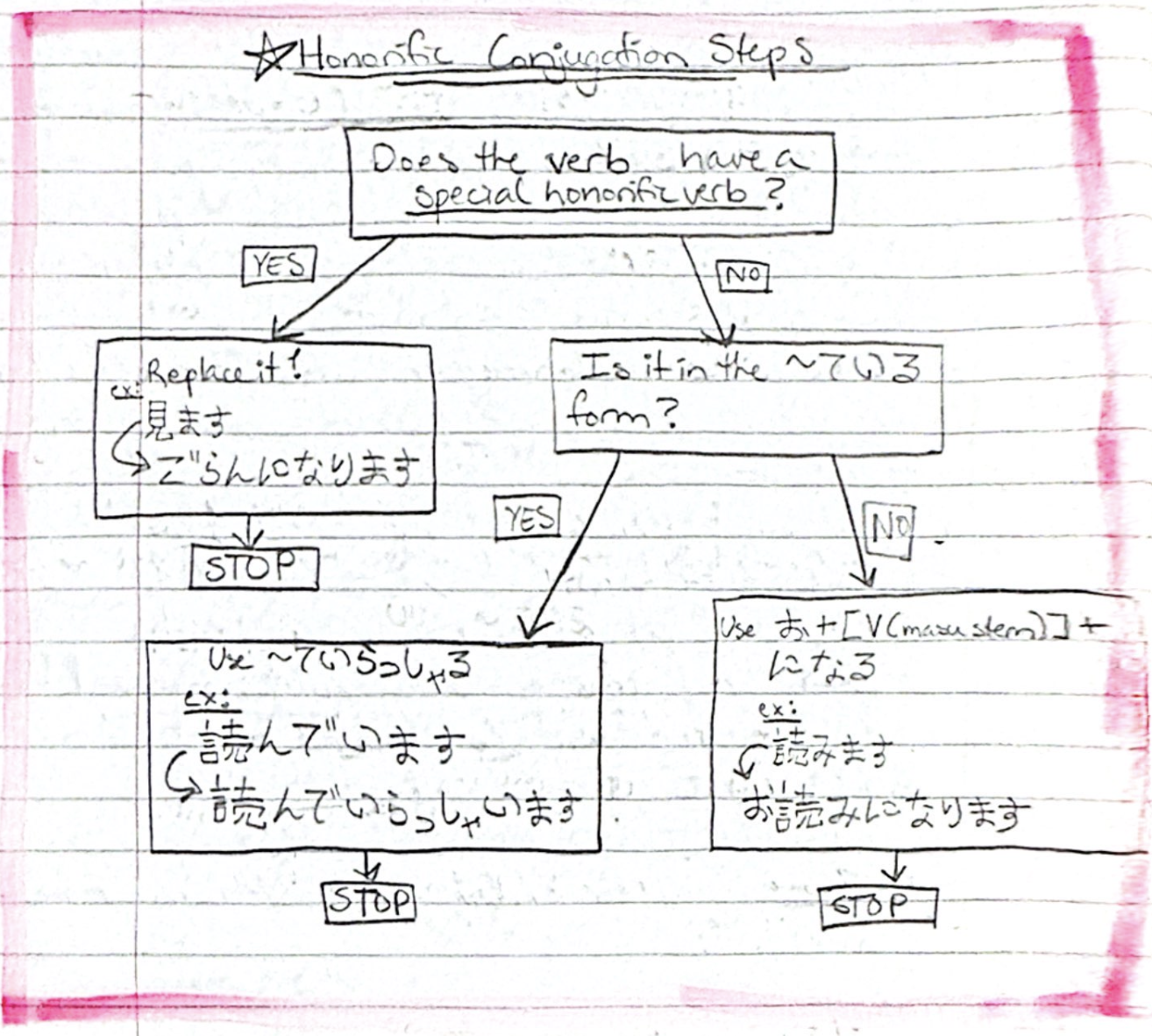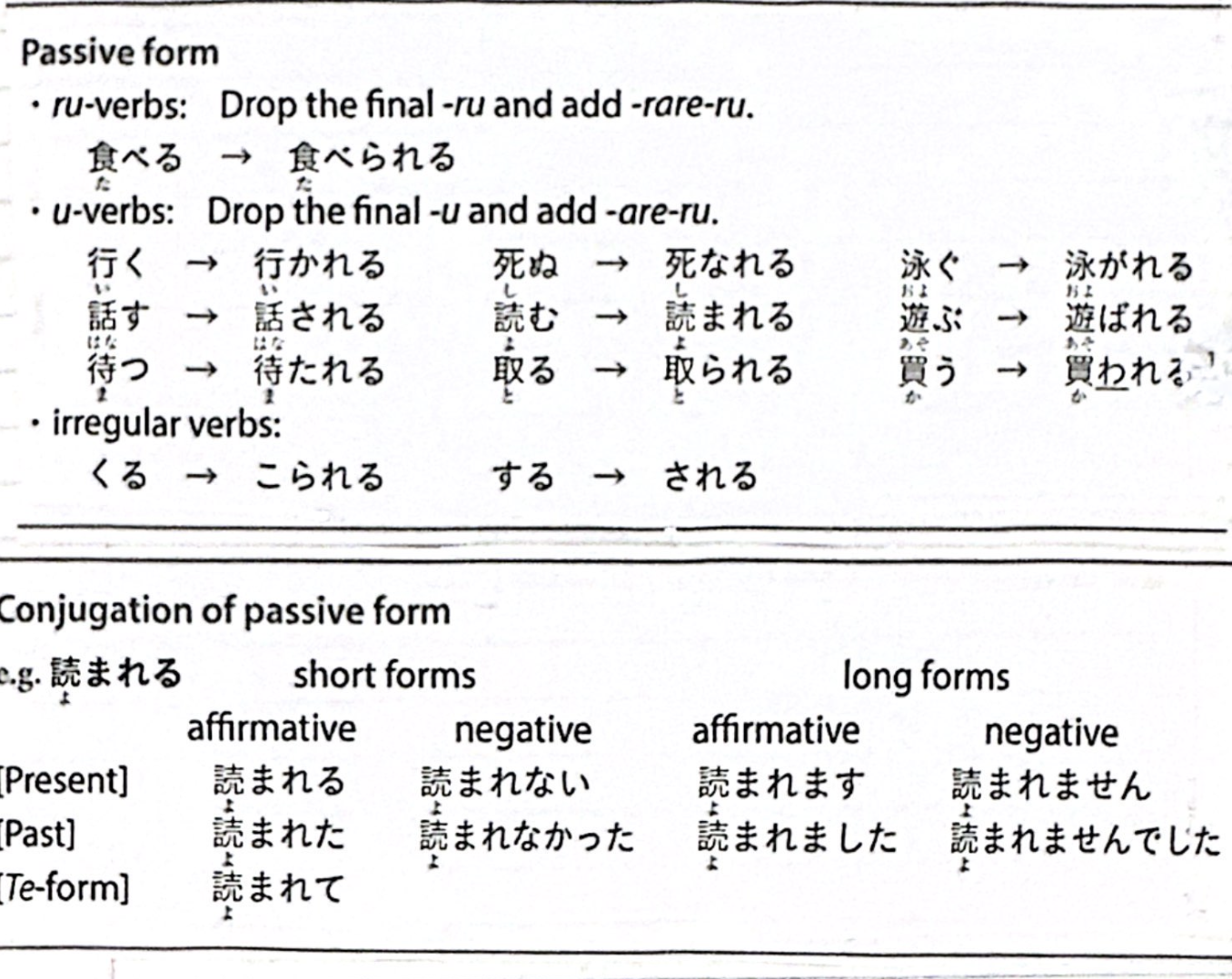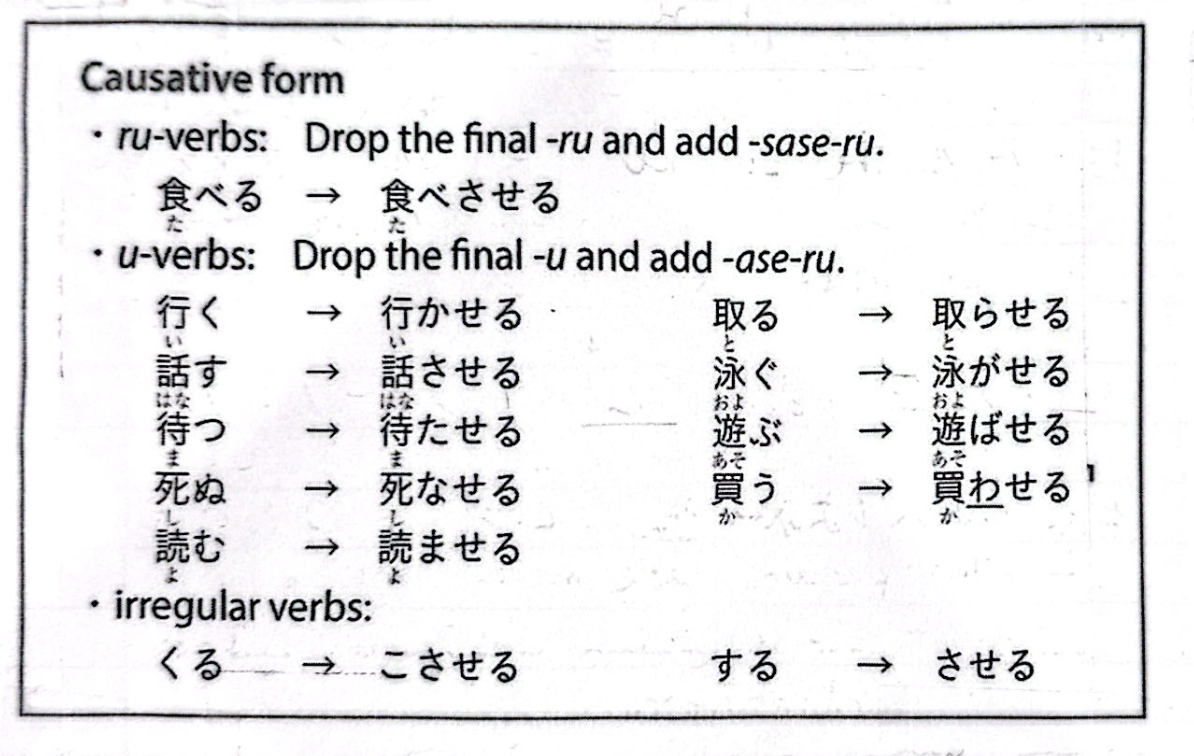L.17 –– L.23 Grammar Structures: NO EXAMPLES
1/87
There's no tags or description
Looks like no tags are added yet.
Name | Mastery | Learn | Test | Matching | Spaced |
|---|
No study sessions yet.
88 Terms
honorific verb for いる
いらっしゃる(いらっしゃいます)
honorific verb for いる
いらっしゃる(いらっしゃいます)
honorific verb for 来る
いらっしゃる(いらっしゃいます)
honorific verb for 食べる
めしあがる(めしあがります)
honorific verb for 飲む
めしあがる(めしあがります)
honorific verb for くれる
くださる(くださいます)
honorific verb for する
なさる(なさいます)
honorific verb for ねる
お休みになる(お休みになります)
honorific verb for 見る
ごらんになる(ごらんになります)
honorific verb for 言う
おっしゃる(おっしゃいます)
honorific verb for 〜ている
〜ていらっしゃる(〜ていらっしゃいます)
what characters go before honorific forms of する?
ご or お. ご is used w/ most kanji compounds, while お is used w/ japanese origin words and a few common kanji compounds.
What are the three steps for making a sentence honorific form?
If there are verbs with special honorific equivalents, replace the special honorific verbs. —> then, done!
If there are no special verbs, but the verb is in 〜ている form, simply change it to 〜ていらっしゃる. —> then, done!
if there are no special honorific verbs, use [お + (verb stem) + になる ]. —> then, done!
Respectful advice form (“please do X… [for your own good]” structure)
お + [V (masu stem) ] + ください OR ご + [ V (する stem) ] + ください
HOWEVER, if a verb has a honorific equivalent, that form is used instead, and in a 〜てください structure.
“Thank you for [verb]-ing me/us” structure: CASUAL
[ V (te-form) ] + くれてありがとう
“Thank you for [verb]-ing me/us” structure: FORMAL
[ V (te-form) ] + くださってありがとうございます
“Im glad X was the case” / “It is good that X happened” sentence structure
〜てよかったです
What is the difference between “I should have done X” and “I am glad I did X” structures?
“should have done”: 〜ばよかったです (NOT て)
“glad I did”: 〜てよかったです
Remember, if someone asks you a question in honorific form, what do you do when you answer?
You change it back to regular form! NEVER use honorific form to refer to yourself.
Special forms for respectful advice (special exception phrases):
おめしあがりください (please eat- respectful advice)
休みください (please rest- respectful advice)
ごらんください (please look- respectful advice)
For “It is good that X happened” sentences, you must always make them part of a larger から or ので sentence that adds context about WHY you’re glad.
ok got it slay

awesome fucking honorific sentence creation/conversion chart
okay ateeeee
“should be” / expectation sentences structure
[ V or い-adj (plain form) ]* + はずです
*if a noun or a な-adj. is being used, add の after the noun or な after the な-adj.
いる courteous form
おります(おる)
行く courteous form
まいります(まいる)
来る courteous form
まいります(まいる)
言う courteous form
申します(申す)
する courteous form
いたします(いたす)
食べる courteous form
いただきます(いただく)
飲む courteous form
いただきます(いただく)
ある courteous form
ございます(ござる)
〜ている courteous form
〜ております(〜ておる)
〜です courteous form
〜でございます(〜でござる)
Modest/courteous form of 私
わたくし (still written in kanji as 私)
humble form structure
お + [ V (masu stem) ] + する
if this actually involves a する verb, add ご or お before the verb instead.
note that humble expressions can only be used when describing an action of yours that involves the person you want to show respect to.
ok got it slay
List the verbs with special humble equivalents.
聞く —> うかがう
もらう —> いただく
あげる —> さしあげる
List the verbs that you must memorize the お and ご for in honorific form.
ご+しょうかいする (to introduce)
ご+あないする (to show [someone] around)
ご+せつめいする (to explain)
を+電話する (to call)
“without V-ing” / “Instead of V-ing” sentence structure
[ V ] + ないで
What are the rules for embedded question markers?
plain form* PLUS….
Yes-no questions are followed by 〜かどうか , while wh-questions are followed by just 〜か。(after the descriptor / verb / etc. ), I’m not talking about the question marker か lol.
*for なーadj. , must omit the な from the plain form. Everything else is regular plain form.
“thing named X” sentence structure
[name] + という + [item]
“easy to X / hard to X” sentence structure
[ V (masu stem) ] + [ やすい / にくい ]
やすい and にくい sentence strucyure is NOT used with skill related topics. Instead, for such sentences, use やさしい and むずかしい like you ordinarily would.
ok got it slay
[victim]は[villain]に[evil act]
passive sentence structure

ru: drop final ru and add rare-ru
u: drop final u and aded are-ru
irregular: 来る—> 来られる and する—>される
passive form conjugation
〜が + verb + てある
something has been done (and kept that way).
[event A] + [ている] + 間に + [event B]
something happens during another longer event.
〜ほしくないです OR [verb negative]ほしいです。
NEGATIVE form of “i want someone to do something”
[director] は [cast] に [thing]
“I made someone do something”

ru: drop ru, add sase-ru
u: drop u, add ase-ru
irregular: 来る—>来させる and する—>させる
causative form conjugation
causative + てあげる / てくれる / てもらう
“let someone” structure
causative + てください
“please let me do something”
V(masu stem) + なさい。
firm command form
[clause A] 〜ば [clause B]
if ___, then (good result)
Thing A[short form]* + のに + thing B
*if a noun or na-adj, this means ending in な.
despite A, B is true”
[thing A] のように [thing B]
X is like Y (comparison statement)
[thing A] のような [thing B]
X is like Y (example statement)
hearsay sentence structure
[verb or adjective plain form (dictionary or short past, or short negative)] + そうだ (casual)/ そうです (polite)/ って (more common casual)
according to….
〜によると
difference between “looks like” and “i heard” sentence structure
“looks like” = short form of the adj. or verb, “i heard” = long form of the adj. or verb.
(A) おいしそうです。
(B) おいしいそうです。
which one is “i heard it’s delicious” and which one is “it looks delicious?”
(A) is “looks delicioius”. (B) is “i heard it’s delicious”.
what do you add to な-adjectives and nouns when making the “i heard” structure?
だ
たら form structure (“if / when” sentence)
past plain tense conjugation, either affirmative or negative (食べた、食べなかった、etc.) , followed by ら。Also can be used with nouns + だ or adjectives, but then you have to add the たら after the だ。
How do you specify that you mean “if” and not “when” in an ambiguous “たら” sentence?
you add もし to the beginning of the clause.
what particle does the たら clause use?
が
Structure for “when something happened, to my surprise, X happened”.
main clause following the たら clause is changed to past tense.
みたい or よう sentence meaning
something is like something else. みたい is more colloquial thanよう
みたい attaches directly to the preceding noun, while よう requires の after the noun.
ok yass bitch slay i got it >:)
What verb do you use to say something is different from something? (Since you cannot use みたい or よう in the negative)
ちがう (dictionary form; “to be different”)
みたい and よう function as ______ when used in noun-modifying sentences.
な-adjectives
What is みたい or よう followed by when modifying a verb or adjective? (Similar to a noun-modifying sentence, but not quite the same!)
に
“____ looks like a _____” sentence structure
[ noun1 ] は [noun2] { みたい / のよう } に見えます。
“before X” / “after X” structures
[ V ] 前に / [ V ] 後で
for nouns: add の before the 前に or 後で
for verbs: use dictionary form or short past form of the verb, then just 前にor 後で without の
I must not eat
I have to eat
I am allowed to eat
I don’t have to eat
食べてはいけません
食べなければいけません
食べてもいいです
食べなくてもいいです
If the subject of the 前に or 後で clause differs from that of the main clause, it is marked by the particle が
ok i got it yass
What form do you use INSTEAD of 後で if the 1st action triggers the 2nd action?
[ V (te form) ] + から
If an action is followed by a event, which structure should you use, [ V (te form) ] + から OR [ V ] + 後で ?
[ V ] + 後で
remember to practice the transitive verbs quizlet >:)
ok yass i will!
“to one’s regret” sentence structure
[verb (te form) ] + しまいました
casual form: ~てしまった
casual conjunction: 〜てちゃった or 〜てじゃった
When S1 occurs, S2 follows (sentence structure) (if / when statement")
(S1 [verb dictionary form] ) と ( S2 )
When you describe a state using S1 と S2, you must describe it as “becoming the state” instead of the state itself (ex. “it becomes cold” rather than “it is cold”).
ok got it yasss
simultanous action sentence structure
[ V1 (masu stem form) ] + ながら + [ V2 ]
In simultainious action structure, which verb is the “main” verb?
The second one (V2).
“I should have / shouldn’t have done” sentence structure
[V1 (ba-conditional form) ] + ばよかった
how do you get the ba-conditional form of a verb?
affirmative: change the final “u” form to “e” and attach ば
negative: change ない to なければ
〜ばよかった is usually used together with 〜てしまいました. It is important to add context with a 〜てしまいました sentence before saying a 〜ばよかった sentence.
ok got it slay
what is the colloquial form of なければ?
なきゃ
What is the difference between まで vs までに?
まで —> “until” [time]
までに —> “by” [time]
NOT to be confused with 前に (“before [X]” )